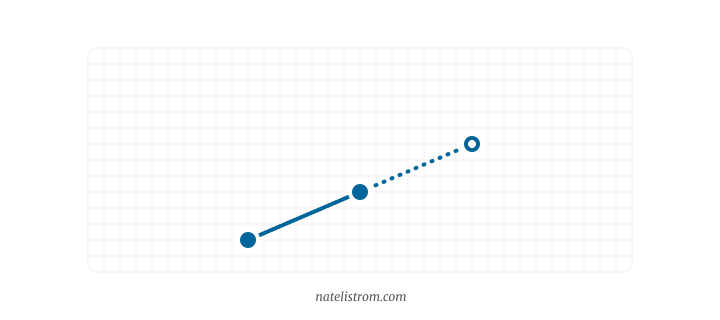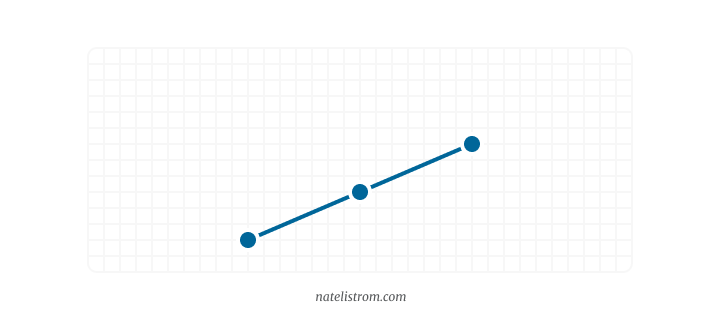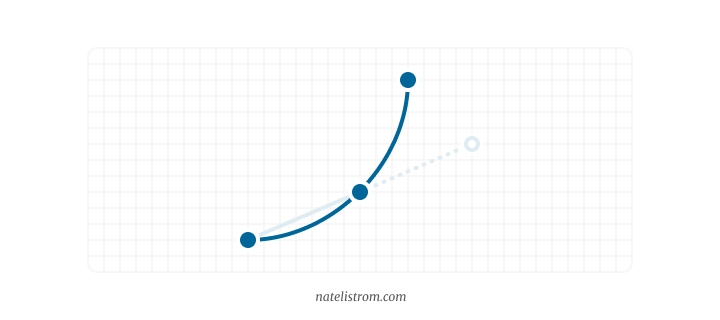Storytelling, neuroscience, and the rule of three: prediction and reward
Summary: The most satisfying execution of the rule of three hooks into your audience’s brains’ reward systems by perfectly fulfilling the promise of the setup, but doing it in a way that subverts their expectations.
In a previous note, I introduced the rule of three, a powerful storytelling mechanic that lets you set up a trajectory for your audience’s expectations and then pay it off in a satisfying way.
In this note, we’ll dive a bit deeper into the neuroscience and psychology behind why the rule of three is so powerful and how to maximize its effectiveness. We’ll focus on how predictions are tied to satisfaction.
Prediction and payoff
The rule of three works by using the juxtaposition of the first two items to establish a trajectory, an expectation for what the third item will be.

The most basic execution of the rule of three pays off the expectation by more-or-less fulfilling the prediction in the most direct, straightforward manner.
“When you name several things you save the most impressive for last. ‘The Mayor,’ you say, ‘was there, and the Governor — and the President!’”
— Lajos Egri (Egri, Page 258)

However, the most satisfying execution of the rule of three is when the third story unit perfectly fulfills the promise of the first two but in a way that subverts the audience’s expectations.

Webcomic author and Writing Excuses podcast co-host Howard Tayler illustrates:
“A great many funny stories are when you are telling a story that is kind of funny and then you get to the end of it and you realize, ‘Oh, I was actually being told a very different story, and that’s kind of hilarious,’ as everything is re-contextualized and new.” (Kowal et al.)
Tayler continues with this example:
“When we had the episode with Jim Hines . . . I introduced him and said, ‘All the men want to be like him, and all the women want to be with those men.’ Which is a fantastic comic drop . . . ‘and all the women want to be with . . . him,’ is what you’re expecting. The very last word is now gone and is now replaced with ‘other men.’” (Kowal et al.) (emphasis mine)
Tayler’s focus is on humor — and to be sure, jokes are one of the places where this setup-and-twist pattern is the most prominent — but it applies broadly. Any deeply satisfying execution of the rule of three will follow this pattern to some degree.
Prediction and reward
Why does it work this way?
Expectation and anticipation are tied to our brains’ reward systems. Our reward systems are built to help us learn, so they’re hard-wired to prefer to novelty. (Schultz, B. Neuronal Signals for Reward Learning section) (van Lieshout, Introduction section) (Kidd and Hayden, The function of curiosity section) They’re tuned to be especially sensitive to new and unexpected information.
Our reward systems detect new information by recognizing what, in the scientific literature, are called reward prediction errors. (Lehne and Koelsch, Neural correlates of tension and suspense section) (Schultz, B. Neuronal Signals for Reward Learning section) A prediction error occurs when your brain recognizes the difference between what it predicted and what actually occurred in the world.
Here’s how neuroscientist Read Montague describes the research in his book, Your Brain is (Almost) Perfect:
“The reward-prediction error signal . . . was first identified using experiments in monkeys, where lights predicted the future arrival of juice squirts a short time later. When the light is initially presented, there is no change in dopamine neuron activity . . . However, the arrival of the juice a short time later causes a burst of activity in the dopamine neurons.” (Montague, Page 113)
The monkeys in the experiments didn’t know what to expect when they saw the flashing light. Their brains’ reward systems made predictions based on whatever past experience they had. Then, when they received the juice, their reward systems recognized that this was different than what they had predicted. They identified a prediction error. (In this case, triggering a dopamine response that told their brains, “Wow! Something better than expected just happened!”) (Montague, Page 113)
Just like the monkeys, when our reward systems recognize a prediction error, they flush our brains with reward signals. (Schultz, B. Neuronal Signals for Reward Learning section)
These signals have a number of effects. For the purposes of our discussion of the rule of three, there are few in particular worth mentioning:
- Reward signals heighten your attention. They flip you out of “autopilot” and tell your brain to focus in on the new phenomenon you are encountering. (Schultz, A. Proximal reward functions are defined by behavior section)
- Reward signals enhance your memory, preparing you to learn any new, beneficial information. (Schultz, C. Dopamine Implementation of Reward Learning section)
- Reward signals stimulate your emotions and subjective experience, giving you feelings that your brain thinks correlate with the phenomenon you are encountering. If your reward system evaluates the outcome as better than expected, this can result in an especially pleasurable experience. (Schultz, D. What Makes Rewards Rewarding? Section) (Berridge and Kringelbach, Pruning false candidates: Mesolimbic dopamine and ‘pleasure electrodes’? section) (Berridge and Kringelbach, A neuroscience of pleasure section)
This is why the rule of three can be so effective when done with a twist. When the third story unit subverts the trajectory (read: prediction) set up by the first two story units, that activates our brains’ reward systems. We recognize a prediction error, which triggers our reward response.
Worse for the protagonist, better for the audience
At this point, it’s worth pointing out that “better than expected” for the audience is different than “better than expected” for the protagonist. In horror stories, for example, the situations in which the characters find themselves are, by definition, terrifying. Yet for the audience, twists and sudden revelations — although startling and frightening — can also be thrilling.
In Jurassic Park there are several excellent executions of the rule of three with horror elements. Let’s look at one example. Here’s the setup: Dr. Sattler has gone to a bunker to reset the island’s power grid. This is a task that Mr. Arnold was supposed to do, but the protagonists have lost contact with him. In the bunker, Dr. Sattler is being hunted by velociraptors.
- Beat one: Dr. Sattler walks down a dark hallway.
- Beat two: Suddenly, she feels a hand on her shoulder. It’s Mr. Arnold. Sattler sighs in relief. She’s not alone.
- Beat three: Then she discovers that there is no body attached to the arm. With horror, she realizes that Mr. Arnold has been eaten . . . and she likely will be as well.
For Sattler, this is a nightmare. Yet for the audience, it’s a great play on our reward systems.
We’re already primed for some kind of attack but hoping for a quiet escape. The “appearance” of Mr. Arnold in the second beat oh-so-briefly sets up a prediction: Sattler and Arnold will work together to escape. Then the third beat subverts expectation, and we realize that Dr. Sattler is in even deeper trouble than we thought. There’s nobody there to rescue her.
Our reward systems flush our brains with positive thrill, and we lean in. “How in the world will she escape now?” This outcome is “better than expected” in the sense that it increases the challenge that Dr. Sattler must overcome and, by doing so, promises an even better story payoff for the audience.
Prediction and learning
Remember that our reward systems are built to help us learn. They adapt quickly, updating our predictions so that we make fewer prediction errors as we go.
Let’s return to Montague’s account of the research with the monkeys.
“If the light-juice pairs are repeatedly delivered to the subject . . . remarkable changes occur. The initial response associated with the juice, the ‘things are better than expected’ response, goes away . . . The neurons no longer change their activity when the juice arrives following the light. This means that the dopamine system has learned to expect the time and amount of juice delivered . . . The neurons now report that the light is ‘better than expected’; that is, they react to the light in the same fashion that they reacted initially to the juice.” (Montague, Page 113) (Emphasis mine.)
The monkeys’ brains had learned the pattern. They began to expect the juice a short time after they saw the light. The light became what Montague calls a “value proxy” for the juice. (Montague, Page 113)
Not all reward signals are equal. Different reward signals trigger during different parts of the learning cycle. Here’s Wolfram Schultz, one of the leading researchers on the topic:
“Some neurons fail initially to respond to novel stimuli and acquire reward discriminatory responses during learning. Apparently they code valid reward predictions. To the opposite, other neurons respond initially indiscriminately to all novel stimuli and differentiate as learning advances, possibly reflecting exploration. A third group of neurons shows reward expectation activity that reflects an initial general expectation and becomes selective for rewarded trials as learning progresses.” (Schultz, B. Neuronal Signals for Reward Learning section)
What this suggests is that there’s a difference between the surprised reward signal that the monkeys experienced when they first received the juice and the expectant reward signals the monkeys received upon seeing the light once they’d learned the pattern.
Prediction and satisfaction
Here’s a key point for storytellers: Positive reward prediction error signals subside once the pattern becomes predictable. (Schultz, B. Neuronal Signals for Reward Learning section)
As our brains get better at predicting a new pattern, they make fewer and fewer prediction errors. Eventually, the “better than expected” signal goes away completely. Like the monkeys, our reward systems may still produce those expectation signals when we see a value proxy, but we no longer experience the benefit of reward when we get to the payoff. The result isn’t better than expected anymore. It’s just . . . expected.
This is why stories that are too formulaic or familiar — too predictable — feel boring. “Familiar patterns are safe,” explains author and story coach Lisa Cron. They don’t capture our attention. (Cron, Page 159)
In storytelling, we’re constantly making promises to our audience, setting up anticipation. Essentially, we’re setting up value proxies, flashing lights.
When the payoff is exactly what our audiences’ brains predicted, their reward systems don’t detect any meaningful prediction errors. This, in turn, tells their brains, “Nothing to see here.” Their attention drifts, and they start looking around for something else that’s more interesting — more likely to produce reward prediction errors.
Thus, the challenge for storytellers is to set up an expectation, creating anticipation, and then somehow deliver more than their audience anticipated, triggering a “better than expected” reward signal.
This is the mechanism behind what playwright David Mamet called “inevitable yet unforeseen,” (Mamet, Location 426) what editor and Story Grid author Shawn Coyne rephrased as, “surprising and inevitable” ending (Grahl) — the ending that perfectly fulfills the promise of the setup but in a way that defies the audience’s expectations.
In the rule of three, the first two story units set up the trajectory, the “value proxy” that tells your audience what to expect. When you deliver with the third story unit, that’s your opportunity to subvert the trajectory and deliver a “better than expected” result.
Change history
July 30, 2023: Added section on the difference between “better than expected” for the audience versus the protagonist.
Rate this note
Subscribe
Email hello@natelistrom.com to get updates as soon as they’re ready.
Read this next
Creating story arcs with three-unit brackets
Bracketing is a three-unit story structure following an A - B - A form. It's often used to illustrate transformation by returning to a familiar image, motif, setting, or situation where something has changed because of the intervening story.